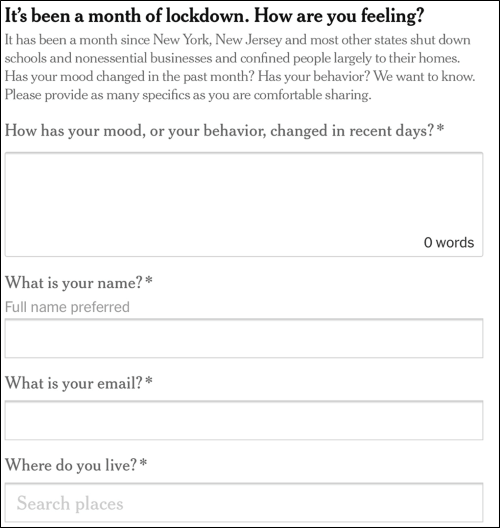And 7 more tips for writing during the pandemic
Here are 7 more tips on writing during the Covid-19 pandemic — or any other crisis.
1. Target your audience with benefits.
One thing I like about the latest Covid-19 update I received from American Airlines: its length. The whole thing weighs in at 172 words.
 One thing I don’t like about this message: It focuses on what American put into these efforts — not on what I’ll get out of them.
One thing I don’t like about this message: It focuses on what American put into these efforts — not on what I’ll get out of them.
Instead of writing about what your organization is doing, position your message in the reader’s best interest with benefits, not features.
- The feature is what it is: little rubber bumpers. Features are nouns, like bumpers.
- The advantage is what it does: They make this chair skidproof. Advantages are modifiers — adjectives or adverbs — like skidproof.
- The benefit is what it will do for you: That means you’ll never scrub skidmarks off your floor again. Benefits are verbs, like scrub.
So trade in your nouns — update, social-distancing measures, gratitude, flexibility, enhancements and commitment — for verbs, like find, fly, rebook, hold and help. (Notice that these are reader-focused verbs — they’re about what the reader will get, not about what American has done.)
Here’s the American Airlines message, with my revisions:
American Airlines CEO, Doug Parker, provides an update on what American is doing to care for customers, team members and the communities we serve throughout the coronavirus (COVID-19) situation.
Learn about:
Find out how you can stay safe and healthy on American Airlines during the coronavirus pandemic, in this video from CEO Doug Parker. He shares how you can:
- How we’ve updated the flight experience and implemented social distancing measures on our aircraft to ensure your safety and the safety of the American Airlines team members serving you.
- Fly safely — and help our team members stay safe — with new social distancing measures on our aircraft
- Our gratitude for support from the U.S. Department of the Treasury.
- Flexibility when planning or rebooking upcoming travel, which includes the ability to cancel your plans for flights through September of 2020, and fly anytime by the end of 2021 without incurring any change fees.
- Cancel or rebook your flights through September 2020 to fly any time in 2021 with no change fees
- Enhancements to the AAdvantage® program allowing for continued elite status through early 2022.
- Hold onto your 2020 elite status through early 2022
- Our unwavering commitment to the communities where our customers and team members live and work through our partnerships with the American Red Cross, local hospitals and more.
- Help us help your community through our partnerships with the American Red Cross, local hospitals and more
- American is committed to keeping you updated and we look forward to welcoming you onboard when the time is right for you.
American is committed to keeping you updated and We look forward to welcoming you onboard when the time is right for you.
Thank you for flying American.
How can you Think Like a Reader to position every message in your readers’ best interest? Find out at our Catch Your Readers Master Class.
2. Report human-interest stories like the Times.
From front-line health care workers battling Covid-19 to New Yorkers bored with sheltering at home, The New York Times has done a great job of telling the stories of people affected by the Covid-19 pandemic.
 How can you find poster people for your own Covid-19 — or other — coverage? Steal a tip from the Times and run an RFS, or request for stories.
How can you find poster people for your own Covid-19 — or other — coverage? Steal a tip from the Times and run an RFS, or request for stories.
The Times has been running RFSs from medical workers on the front lines of the pandemic, people living alone under quarantine, folks who have lost their jobs because of Covid-19, people who feel the pandemic’s effect on nursing homes and more.
The Times asks for text, videos and photos and uses forms and prompts to tease out story elements.
For front-line medical workers, they ask:
- Tell us about the most intense experience you have had fighting Covid-19.
- How has the coronavirus outbreak affected you, i.e., what sacrifices have you had to make to do your job?
- What is the hardest thing about doing your job these days?
- What are you most worried about now and in the future?

How can you use RFSs to report your organization’s human-interest stories?
Want to find, craft and tell awe-inspiring human-interest stories that move people to act? Learn how at our Master the Art of the Storyteller Master Class.
3. How long are your words?
Word length is the top predictor of readability.
 Long words reduce comprehension, suck the color from your piece, sound stuffy and bureaucratic, don’t get shared, make you sound pompous and dense, may seem dishonest and reduce readability.
Long words reduce comprehension, suck the color from your piece, sound stuffy and bureaucratic, don’t get shared, make you sound pompous and dense, may seem dishonest and reduce readability.
That’s important every day. But it’s even more important during a pandemic because: 1) clutter looks like obfuscation; 2) readers are using their cognitive resources teaching the 9-year-old robotics and worrying about infection; and 3) we’re living in an infodemic.
So make your words short.
How short? The New York Times makes big, complex stories accessible to millions of people through words that average 4.9 characters.
Can you do the same? How long are your words?
How can you reach more readers with shorter words? Find out at our Reach Readers Online Master Class.
4. Forget “Communicate early and often.”
“You can’t communicate too often,” says the PR adage.
 Yes. You. Can.
Yes. You. Can.
Especially now.
Literally every organization in the word is affected by this pandemic. And that adds up to a lot of email. Remember what Jimmy Kimmel has to say about that (rant begins at 5:20).
How much is too much? The answer lies not so much in volume as in value. Use “What do they need from us?” as your filter. These thoughts by John Armato are also helpful in deciding what not to send.
Don’t add to the infodemic — or compete with your own essential messages — just to let the people know you’re washing your hands.
How can you make sure your communications don’t overwhelm your audience members? Find out at our PR-writing workshop.
5. Go for the flow.
Do you write? I mean really write.
 I’m not talking about that kind of writing where you hunt for the right word; peck it out; shuffle through your notes looking for some lost quote; then head to the vending machines for the third time in 15 minutes, hoping that when you come back you might — just might — think of something to say.
I’m not talking about that kind of writing where you hunt for the right word; peck it out; shuffle through your notes looking for some lost quote; then head to the vending machines for the third time in 15 minutes, hoping that when you come back you might — just might — think of something to say.
Instead, I’m talking about the joy of what creativity experts call “flow” — when your fingers fly across the keyboard to keep up with all of the brilliant words pouring out of your head.
Wouldn’t that be great about now?
Learn more about freewriting, one of the five steps that will get you into the state of flow.
And master all of the steps in the creative process at our How to Write Better, Easier & Faster Master Class.
6. Need a break?
Me too.
 How about taking a minute right now to read some good news headlines? Make that really, really awesome news headlines. Award-winning headlines, even.
How about taking a minute right now to read some good news headlines? Make that really, really awesome news headlines. Award-winning headlines, even.
Check out the winners of ACES 2019 headline contest. Find ideas and inspiration in winners like:
Companies scramble to replace the egg
And:
Michigan schools are now average. That’s progress
And:
Rock. Paper. Chisel.
See more ACES headline contest winners.
7. Check out these Covid-19 communication tools.
Here are more places to score Covid-19 communications resources:
- Covid-19 resources from IABC
- Crisis communications resources from PRSA
- Daily coronavirus updates from PR News
- Don’t mention the virus! And other marketing tips. What NOT to do when marketing during the pandemic, from The New York Times
- How to Write During Covid-19. Watch this webinar from PRSA and me free with coupon code WYLIE420.
- How to write during Covid-19. Crisis communication guru Molly McPherson interviews me for her podcast.
- Upskill during your downtime with our online Master Classes.
***
What do you need from me during the pandemic? Please hit reply to email me your questions, examples and ideas, I’ll try to address them in the next issue.
See you next week!